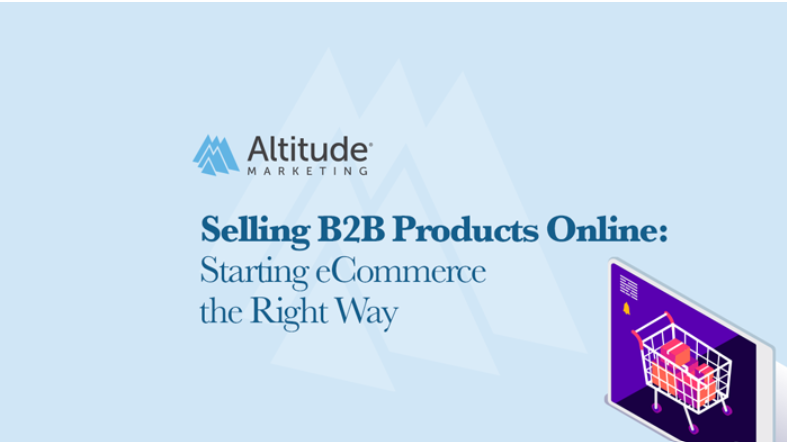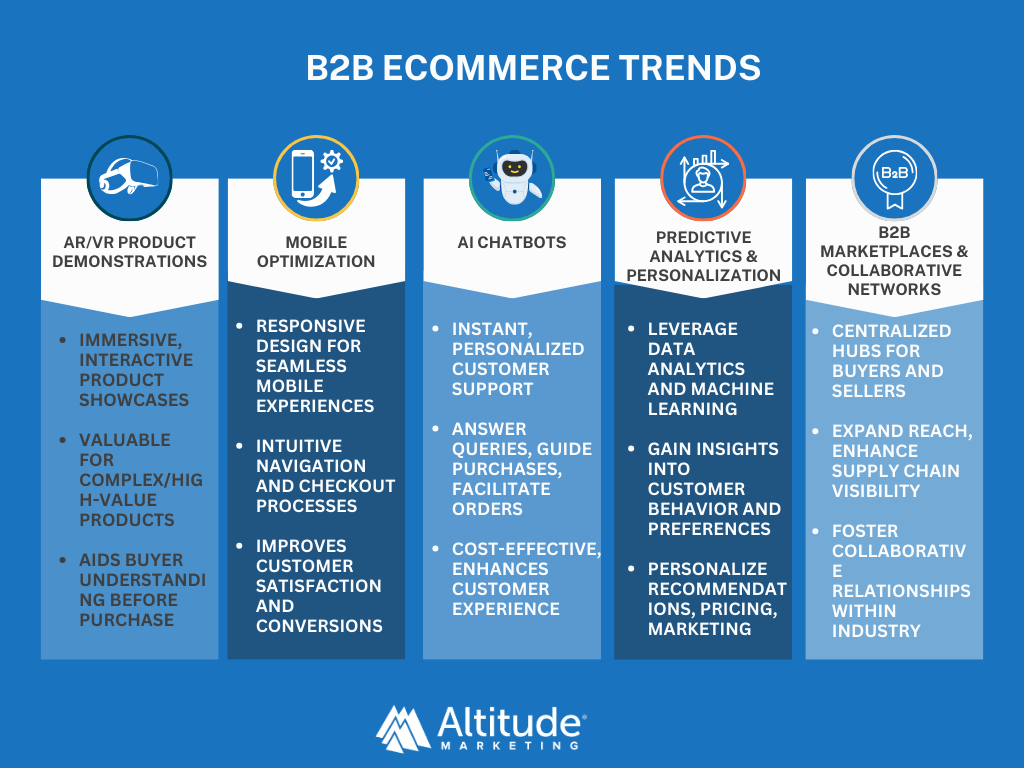Note: This blog was updated October 2024.
Back in the old days, selling B2B products online was rare. Especially for physical products. But in the time of social distancing, business-to-business eCommerce is very much a thing.

Selling B2B Products Online: Starting eCommerce Right
As recently as a few years ago, those B2B companies selling online tried to fit things into their old way of doing things. They’d get orders and invoice in their traditional fashion, net-30. Systems were homegrown and scattershot.
But times have changed.
It’s the age of the customer now. People, especially the younger folks, are used to entering their specs online and getting things on-demand. Heck, it’s gotten to a point where companies such as Amazon have same-day delivery.
It’s all about ease, convenience, and wanting things now.
And with this new wave, more and more B2B companies are starting to sell online. And the good side of eCommerce is that it’s not wildly difficult to start. But it is wildly difficult to do perfectly.
With that being said, here are six things you need to do to effectively sell B2B products online.

Key Benefits of B2B eCommerce:
- Increased reach and access to global markets
- Improved customer experience through self-service portals
- Streamlined ordering and inventory management processes
- Enhanced data-driven decision-making capabilities
- Reduced operational costs and increased efficiency
Year | B2B eCommerce Sales ($ trillion) |
2019 | 1.09 |
2020 | 1.19 |
2021 | 1.36 |
2022 | 1.53 |
2023 | |
2024 | 1.92 |
2025 | 2.13 |
How to Sell B2B Products Online
#1: Pick a Platform
This really ties into security. PCI compliance is critical. The big lesson is: Don’t try to home grow a B2B eCommerce system. There is a chance that you are set up with all of the security measures that you need to do this right, safely, and in a trustworthy manner. But it costs a lot of dough to build up a security blanket from scratch yourself.
Not to worry, because there are many companies that are all incredibly concerned with information security and compliance. It’s their entire job. You can trust that a company that exists because of its security will do its damnedest to do right by you.
So what are some good options? Shopify, for sure. Lots of people use this eCommerce CMS to run their online selling. Magento is more of an enterprise choice. It’s much more developer-friendly, yet it’s a lot harder to use. It honestly comes down to what your B2B eCommerce needs are.
Shopify Plus:
- Pricing: $2,000+ per month
- Key Features: Scalable, user-friendly, robust app ecosystem, multi-currency support, advanced analytics, 24/7 support
- Ideal For: Mid-market and enterprise businesses
Magento Commerce:
- Pricing: Starts at $22,000 per year
- Key Features: Flexible, open-source, developer-friendly, advanced merchandising, B2B functionality
- Ideal For: Large enterprises with complex requirements
BigCommerce Enterprise:
- Pricing: Custom pricing based on needs
- Key Features: Industry-specific features, multi-channel selling, headless commerce, GDPR compliance
- Ideal For: B2B, B2C, and multi-channel businesses
Salesforce B2B Commerce:
- Pricing: Custom pricing
- Key Features: Native Salesforce integration, AI-powered recommendations, account management, contract pricing
- Ideal For: B2B companies using Salesforce CRM
OroCommerce:
- Pricing: Custom pricing based on needs
- Key Features: B2B features like quote management, corporate accounts, workflow management
- Ideal For: Mid-market and enterprise B2B companies
#2: Inventory Management
Do you need to tie your eCommerce efforts into an enterprise resource planning (ERP) system? Or is your business something that you can manage by hand since you’re only expecting a few orders and a few SKUs?
That’ll be really important to consider when doing inventory management planning.
If you have to tie to an ERP since you have bigger orders or more business complexities, you’re looking at a more custom job – which is another way in which Magento can help.
#3: Set Up Payments
It’s important to consider how you’re going to accept payments. Because getting paid is nice.
If you sell B2B products, you likely issue traditional invoices and get paid after the fact.
Won’t work for eCommerce.
I can’t think of the last time I bought something for myself or my business online and I got an invoice (instead of paying right away).
That’s just not how eCommerce works.
Typically, you should be set up for credit card payments. Payment gateways and processors are also a must. You can do this natively to make things streamlined and simple, with something like Shopify.
Sure they’ll get a cut of the sales, but that’s just how it works. 3% or so is pretty standard.
And it would certainly be worth the investment.
#4: Get on the Big Boy Networks
Having a B2B eCommerce store is great, but now you’re competing with behemoths like Amazon and Walmart.
It’s important to make sure you’re not only using your eCommerce platform as a self-contained website. Instead, use it as a place to manage your inventory, your offers, and everything else that you do.
If you take this route, you can now put your products out in places that will get more traffic than your native website, such as the 800-pound gorillas. (Shopify, for instance, will automatically integrate with walmart.com, letting you sell there instantly.)
That means more exposure for you. And more business.
And more moolah.
#5: Marketing
What are you going to do to roll this B2B eCommerce thing out? You probably have to do some special advertising for this. Does that mean using Bing Shopping or Google Shopping? Maybe.
It’s all about what the rest of your ecosystem is doing. If all of your competitors have something in Google Shopping, you probably should, too.
Additionally, you have to consider the one thing we’ve all experienced before: abandoned cart emails.
You know how that story goes. You put something in your cart, you get an outreach from the company saying “please come back for 10% off” – and these things can be automated natively or by using a marketing automation platform.
Bringing people back to your company can be a huge driver for revenue. When considering all of that abandoned cart, if you can pull back even 6-8% of the people you lost before, you’ve pulled in a ton of revenue, which is always a plus.
Another crucial consideration when setting up your B2B eCommerce operation is deciding whether to sell directly through your own platform or leverage the reach of third-party marketplaces. This decision can significantly impact your branding, customer experience, profit margins, and overall sales strategy.
Direct vs. Marketplace Sales
When it comes to selling B2B products online, businesses have two primary options: selling directly through their own eCommerce platform or utilizing third-party marketplaces. Each approach has its own advantages and disadvantages, and the ideal choice depends on factors such as product type, target market, and available resources.
Selling Directly Through Your Own Platform
Pros:
- Complete control over branding, user experience, and customer data
- Ability to offer customized solutions and personalized service
- Potential for higher profit margins by avoiding marketplace fees
- Greater flexibility in pricing, promotions, and inventory management
Cons:
- Requires significant upfront investment in building and maintaining an eCommerce platform
- Responsibility for driving traffic and marketing efforts falls solely on the business
- Limited access to established customer bases compared to large marketplaces
Utilizing Third-Party Marketplaces
Pros:
- Access to established customer bases and built-in traffic
- Reduced upfront costs and technical responsibilities
- Streamlined order and payment processing
- Opportunities for increased visibility and discoverability
Cons:
- Lack of control over branding and customer experience
- Potential for intense competition and price wars
- Fees and commissions can impact profit margins
- Reliance on the marketplace’s rules and policies
Choosing the best approach depends on the specific needs and goals of the business. For example, companies with highly specialized or customizable products may benefit from selling directly through their own platform, where they can offer personalized solutions and maintain control over the customer experience. On the other hand, businesses with more standardized products or those seeking to rapidly expand their reach may find marketplaces advantageous, leveraging their established customer bases and streamlined selling processes.
Ultimately, businesses should carefully evaluate their product offerings, target market, and available resources to determine whether a direct eCommerce approach, marketplace strategy, or a combination of both is the most effective path forward for their B2B online sales.
Whichever approach you choose – direct sales, marketplaces, or a combination of both – it’s essential to have a solid understanding of analytics and performance tracking to optimize your B2B eCommerce efforts.
#6: Analytics and Performance Tracking
Fortunately, when it comes to this stuff, Google Analytics does a pretty gosh darn good job of breaking down eCommerce revenue right out of the box. It can tell you individual orders by day, by SKU, by category – pretty much however you want to break it down.
If you do some of the primary grunt work, Google Analytics will be able to tie and attribute your revenue to specific actions. This is hugely important in seeing what things you’re doing right and what could use improvement.
If it’s organic search it’s your SEO work. If it’s paid search then it’s obviously your paid search. Pretty straightforward for tracking the B2B products you sell online.
As tempting as it may be, we strongly urge you to avoid the one pitfall that most advertisers fall into when considering analytics: looking at spend and gross revenue.
If you spend $2,000 on a campaign and sell $4,000 worth of product, it probably looks good.
But the fact of the matter is, most sellers are looking at 20-40% margins. So your ROAS on the campaign might have only been $1,000.
(That’s bad.)
The moral of the story is, anytime you’re looking at B2B eCommerce analytics, don’t look at gross revenue. Look at post-margin net revenue instead.
The magic number with ROAS is 3x, by the way.
You want to your post-margin net revenue to be three times what you spent on ads.
Effective B2B Sales Strategies for eCommerce Success
Having a powerful eCommerce platform is essential, but achieving outstanding B2B sales requires much more. Building strong relationships, understanding your customers deeply, and utilizing data-driven insights are key to unlocking long-term success. Here are some proven strategies to elevate your B2B sales processes:
1. Nurture Meaningful Relationships
B2B sales often involve longer decision cycles with multiple stakeholders. Establishing trusting relationships is crucial. Stay engaged through personalized communication, attentive follow-ups, and demonstrating a genuine understanding of their unique business needs.
2. Develop Comprehensive Buyer Personas
Create detailed profiles that capture the demographics, pain points, objectives, and decision-making processes of your ideal customers. Tailoring your messaging, offerings, and sales approach to resonate with these personas will drive better results.
3. Implement Account-Based Marketing (ABM)
ABM focuses sales and marketing efforts on specific high-value accounts. By aligning all your activities around these key targets, you can deliver hyper-relevant content and increase conversions.
4. Embrace Consultative Selling
Don’t just pitch products; position your sales team as trusted advisors providing valuable guidance to solve your client’s challenges. This consultative approach builds credibility and cements your role as an indispensable partner.
5. Leverage Data-Driven Insights
Utilize analytics tools to gain a deeper understanding of customer behavior, sales trends, and campaign performance. These data-driven insights will help you identify opportunities, optimize processes, and make informed decisions about prioritization and targeting.
6. Streamline with Automation and CRM Integration
Integrate your eCommerce platform with a Customer Relationship Management (CRM) system to centralize lead management, sales tracking, and customer communication. Automation tools can nurture leads, schedule follow-ups, and surface sales opportunities.
7. Continuously Upskill Your Sales Team
Invest in regular training to equip your team with up-to-date industry knowledge, sales techniques, and comprehensive product expertise. Ongoing development ensures they can effectively articulate your value proposition and address customer concerns.
By implementing these powerful B2B sales strategies alongside your robust eCommerce platform, you’ll forge deeper customer connections, deliver exceptional buying experiences, and drive sustained business growth.
As the business world continues to evolve, embracing digital transformation has become essential for B2B companies to stay competitive and meet changing customer expectations. Integrating digital technologies and strategies into your sales processes can unlock numerous benefits and drive long-term success.
Digital Transformation Insights
Digital transformation presents a wealth of opportunities for B2B businesses to streamline operations, enhance customer experiences, and boost sales efficiency:
- Omnichannel Experiences: Implement a seamless, integrated approach across online and offline channels for a consistent, personalized customer journey.
- Self-Service Portals: Empower customers with self-service tools like product configurators, allowing them to research and customize solutions independently.
- Automated Lead Management: Leverage marketing automation tools for efficient lead generation, nurturing, and conversion through targeted campaigns and personalized content.
- Data-Driven Insights: Integrate eCommerce with CRM and analytics tools to gain valuable customer data, enabling informed decisions on product development, pricing, and marketing strategies.
- Remote Selling and Collaboration: Utilize virtual communication platforms and collaboration tools to facilitate seamless interactions with customers, regardless of location.
Continuously adopting digital technologies and strategies will enable your B2B business to adapt to evolving buyer expectations, foster stronger customer relationships, and maintain a competitive edge.
By combining a robust eCommerce platform, strategic sales approaches, and a commitment to digital transformation, you can position your B2B business for sustained success in the dynamic online marketplace
Staying up-to-date with the latest B2B eCommerce trends is crucial for seizing new opportunities. The following infographic showcases key developments that are transforming how businesses sell and engage customers online.

FAQs
How do I start a B2B sales program?
To start B2B sales, identify your target market, research potential clients, build a sales pipeline, and reach out through methods like cold calling, email marketing, networking, and leveraging existing connections.
Is B2B sales profitable?
Yes, B2B sales can be very profitable, especially for companies selling high-value products or services to other businesses. B2B transactions often involve larger deal sizes compared to B2C sales.
What are B2B sales products examples?
Some examples of common B2B products include industrial equipment, raw materials, office supplies, software/SaaS, logistics services, financial services, consulting services, and advertising/marketing services.
These are the six pitfalls that a lot of folks fall into when getting started with B2B eCommerce. But not to worry. If you think about all of these things and put in the effort to jumpstart your eCommerce efforts the right way, you could build an eCommerce store in like a day.
If you really want to.
Would it be absolutely perfect? Probably not.
But could you still do it and start selling stuff today? Sure, why not?
Once you tweak your B2B online selling efforts over time and make things better as you go, you can join the many millions of people who sell their fair share of stuff online.



